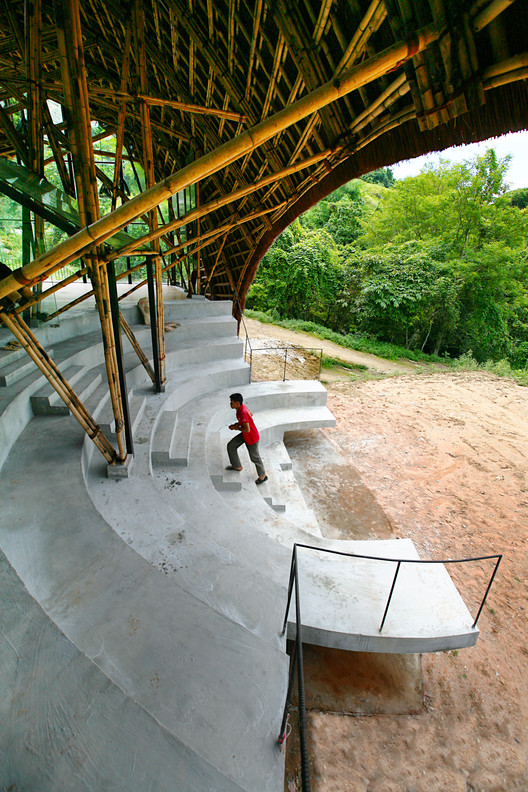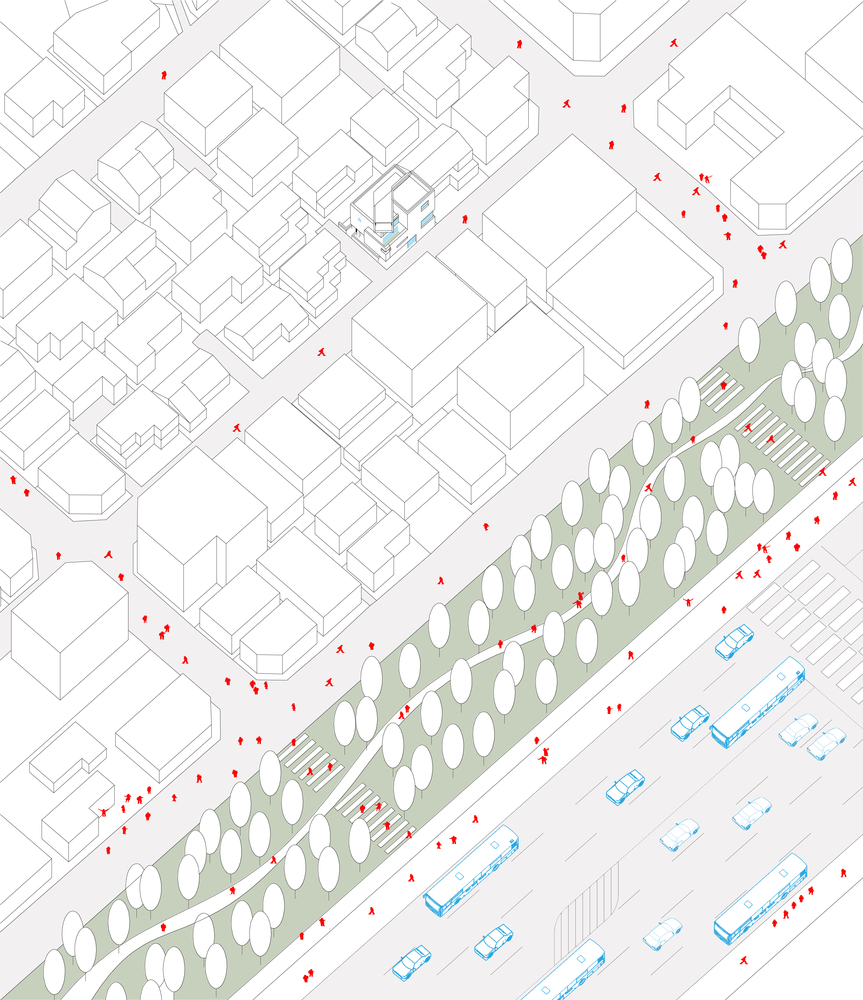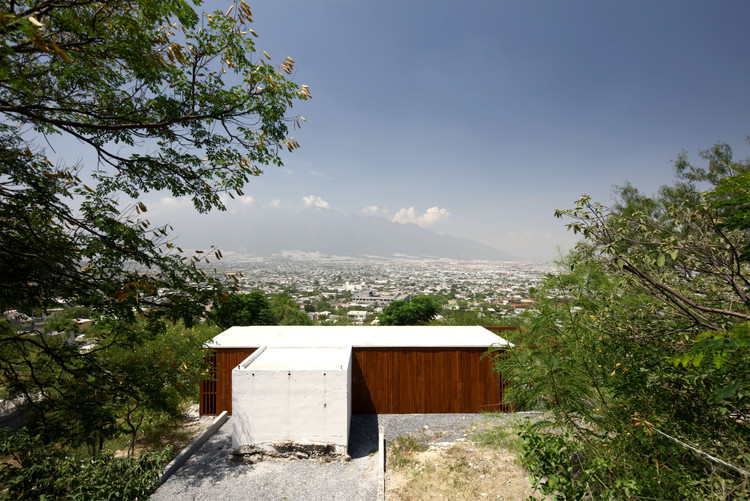AD Classics Menara Mesiniaga T. R. Hamzah - Yeang Sdn. Bhd.
2015-09-28 08:00
杨虽然出生在马来西亚,但他在英国和美国学习,先是在伦敦的建筑协会(AA)学习,然后在剑桥大学学习生态学,最后在宾夕法尼亚大学学习伊恩·麦哈格(Ian McHarg)领导的景观项目。[1]他的生态学研究让杨对建筑与环境之间的关系产生了浓厚的兴趣,麦哈格鼓励的适合地区的设计将对他后来的工作产生重大影响。[2]回到马来西亚后,杨致远与其他AA校友滕库·罗伯特·哈姆扎(Tengku Robert Hamzah)一道,在1976年创立了T·R·哈姆扎(T.R.Hamzah)和叶(Yeang)两家公司。
Though born in Malaysia, Yeang studied in England and the United States, first at the Architectural Association (AA) in London, then at the University of Cambridge where he also studied ecology, and finally at University of Pennsylvania for a landscape program under Ian McHarg.[1] His study of ecology gave Yeang a keen interest in the relationship between buildings and the environment, and the regionally appropriate designs encouraged by McHarg would have a significant influence on his later work.[2] After returning to Malaysia, Yeang joined with fellow AA alumnus Tengku Robert Hamzah to create the firm T. R. Hamzah and Yeang, in 1976.[3]
对环境负责和区域适应性设计的兴趣似乎与摩天大楼的类型截然相反,但在杨看来,在迅速城市化的世界里,摩天大楼的无处不在是一个必然的结论:“为什么不尝试改进它,使它对环境无害。”[4]杨在他的书的导言中清楚地看到了他对这方面的野心的规模,当他说“摩天大楼设计理论可能在一定程度上来源于节能伦理”时,这位“摩天大楼”的生物气候学家认为,“未来摩天大楼的设计理论可能会在一定程度上源于节能道德。”
An interest in environmentally responsible and regionally adaptive designs seem diametrically opposed to the skyscraper typology, but in Yeang’s view the ubiquity of the skyscraper is a foregone conclusion in a rapidly urbanizing world, “why not try to improve it and make it environmentally sound.”[4] The scale of Yeang’s ambition to this effect is clear in the introduction of his book, The Skyscraper Bioclimatically Considered, when he says, “The theory of skyscraper design might, in the future, be derived in part from the ethic of energy conservation.”[5]
为ibm的马来西亚子公司建造的,梅娜拉梅西尼亚加的高科技外观掩盖了杨在大楼中使用的被动策略。建筑形式作为各种被动太阳能和自然通风原理的图表,为设计提供了依据。圆形塔的结构是由八根柱支撑在建筑围护结构外,允许在内部最大限度的灵活性。自然通风电梯和楼梯核心位于建筑物的东侧,以阻止太阳从强烈的早晨阳光。
Built for IBM’s Malaysian affiliate, the high-tech appearance of the finishes of the Menara Mesiniaga belies the passive strategies that Yeang employed in the building. The building form serves as a diagram of the various passive solar and natural ventilation principles that informed the design. The structure of the circular tower is supported by eight columns just outside the building envelope, allowing maximum flexibility on the interior. The naturally ventilated elevator and stair core is located on the east side of the building to block the solar gain from the intense morning sun.
这座塔从基地的人工护堤上升起,从圆柱形正面雕刻而成的景观“天坛”螺旋形上升。除了促进空气流通和自然通风,天空法院为建筑使用者提供了一种与自然的联系,这与典型商业建筑的单调形成鲜明对比。天空的深凹也为相邻的室内空间提供阴影,而地板到天花板的玻璃和滑动玻璃门保持与外部的联系。
The tower rises from a planted berm at the base, and the vegetation continues upward in a spiral of landscaped “sky courts” carved from the cylindrical facade. In addition to promoting air circulation and natural ventilation, the sky courts provide a connection to nature for the building occupants, in stark contrast to the monotony of typical commercial construction. The deep recesses of the sky courts also provide shading for adjacent interior spaces, while floor-to-ceiling glazing, and sliding glass doors maintain contact with the exterior.
Diagram of Skycourts, Courtesy of T. R. Hamzah & Yeang Snd. Bhd.
© Aga Khan Trust for Culture/Aga Khan Award for Architecture/Courtesy of architect/NG K.L. (photographer)
c阿加汗文化信托基金/阿加汗建筑/建筑师礼貌奖/吴克伦(摄影师)
为了补充天空庭院,正面被处理铝百叶窗,帮助防止太阳热量增加。百叶窗的布置说明了该地点的赤道太阳路径:受到最少直接阳光照射的南北立面都有薄薄的条状百叶窗遮挡,而建筑物的西面则被几乎覆盖整个窗户的宽铝带遮挡住午后的刺眼阳光。
To supplement the sky courts, the facade is treated with aluminum louvers that help prevent solar heat gain. The arrangement of the louvers illustrates the equatorial solar path at the site: the north and south facades, which receive the least direct sunlight, are shaded with thin strip louvers, while the western face of the building is shielded by wide bands of aluminum that almost cover the entire window to block the harsh afternoon sun.
在塔顶,一个钢管的皇冠是为了支持未来安装光伏电池板,以补充建筑物的电力需求。这顶树冠还为游憩区和屋顶甲板上的游泳池提供遮阳和保护。
At the top of the tower, a crown of tubular steel is intended to support a future installation of photovoltaic panels to supplement the electricity needs of the building. This crown also provides shading and protection for the recreation area and swimming pool on the roof deck.
Diagram of Solar Shading, Courtesy of T. R. Hamzah & Yeang Snd. Bhd.
© Aga Khan Trust for Culture/Aga Khan Award for Architecture/Courtesy of architect/NG K.L. (photographer)
c阿加汗文化信托基金/阿加汗建筑/建筑师礼貌奖/吴克伦(摄影师)
在室内,杨在楼板中央安排了私人办公室,在周边附近放置了开放的办公空间-十多年前,伦佐·皮亚诺(Renzo Piano)在纽约时报大厦(New York Times Building)采用了同样的技术。私人办公室有玻璃墙,使整个室内的自然光得到最佳利用。
On the interior, Yeang arranged private offices in the middle of the floor plates, placing open office spaces near the perimeter–more than a decade before Renzo Piano employed the same technique at the New York Times Building. The private offices have glazed walls that allow for optimal utilization of natural light throughout the interior.
© T. R. Hamzah & Yeang Sdn. Bhd.
1995年,该建筑获得了阿加汗建筑奖。每隔三年,“该奖旨在确定和鼓励建立概念,成功地满足世界各地社会的需要和愿望,穆斯林在这些社会中有着重要的存在。”评审团赞扬了这座建筑独特的设计和对气候的响应能力。陪审员查尔斯·詹克斯(Charles Jenks)称赞这座塔是“一种引人注目的替代企业大厦统治模式的选择,也是当代建筑的一种新的综合体,它对特定地区的气候做出了反应,并从最终是宇宙的力量中获得了一种新的建筑语言的灵感。”[6]彼得·艾森曼(Peter Eisenman)也是陪审团成员。简单地说:“梅娜拉·梅西尼亚加是少数几个为建筑的总体文化贡献新思维的项目之一。”
In 1995 the building received an Aga Khan Award for Architecture. Given every three years, “the Award seeks to identify and encourage building concepts that successfully address the needs and aspirations of societies across the world, in which Muslims have a significant presence.” The award jury praised the unique design and climate responsiveness of the building. Juror Charles Jenks hailed the tower as “a striking alternative to the reigning mode of corporate towers and a new synthesis for contemporary architecture that is responsive to the climate of a particular place and finds inspiration for a new architectural language from forces that are ultimately cosmic.”[6] Peter Eisenman, also a member of the jury, simply remarked that “Menara Mesiniaga is one of the few projects that contributes new thinking to the general culture of architecture.”[7]
© T. R. Hamzah & Yeang Sdn. Bhd.
杨的远见卓识之塔并非没有弱点。多个来源报告说,炎热潮湿的气候导致金属表面生锈和腐蚀,并在天空法院的地板上汇集水。
Yeang's visionary tower was not without its weaknesses. Multiple sources have reported that the hot humid climate has contributed to rust and corrosion on the metal finishes, and pooling of water on the floors of the sky courts.
也许梅娜拉·梅西尼亚加最大的成就是它对东南亚热带气候之外的其他建筑师的影响。在超高层摩天大楼时代,梅娜拉·梅西尼亚加(Menara Mesiniaga)的15层小建筑对高层建筑设计产生了巨大影响。杨的天宫螺旋影响了诺曼·福斯特(NormanFoster)在伦敦的瑞士再保险总部(又称“Gherkin”)[8]等标志性建筑,在Gensler‘s上海大厦的设计中也可以找到类似的策略。
Perhaps Menara Mesiniaga's greatest achievement is its influence on other architects, beyond the tropical climate of Southeast Asia. In the era of the supertall skyscraper, Menara Mesiniaga’s diminutive fifteen stories has had an outsized influence in tall building designs. Yeang's spiral of sky courts has influenced such iconic structures as Norman Foster’s Swiss Re headquarters in London (also known as “The Gherkin”) [8], and a similar strategy can also be found in the design of Gensler’s Shanghai Tower.
Example Floor Plan, Courtesy of T. R. Hamzah & Yeang Snd. Bhd.
[1]鲍威尔,罗伯特。重新思考摩天大楼:杨健的完整建筑。纽约:惠特尼设计图书馆,1999年。P8-12。
[1] Powell, Robert. Rethinking the Skyscraper: The Complete Architecture of Ken Yeang. New York: Whitney Library of Design, 1999. p8-12.
[2]Steele,James。生态建筑:一部批判的历史。伦敦:泰晤士河
[2] Steele, James. Ecological Architecture: A Critical History. London: Thames & Hudson, 2005. p194.
[5]是的,肯。天敌生物气候考虑。伦敦:学院版,1996年。P10。
[5] Yeang, Ken. The Skyscraper Bioclimatically Considered. London: Academy Editions, 1996. p10.
Architects T. R. Hamzah & Yeang Sdn. Bhd. Location Menara Mesiniaga, Ss 16, 47500 Petaling Jaya, Selangor, Malaysia Category Office Buildings Project Year 1992
 举报
举报
别默默的看了,快登录帮我评论一下吧!:)
注册
登录
更多评论
相关文章
-

描边风设计中,最容易犯的8种问题分析
2018年走过了四分之一,LOGO设计趋势也清晰了LOGO设计
-

描边风设计中,最容易犯的8种问题分析
2018年走过了四分之一,LOGO设计趋势也清晰了LOGO设计
-

描边风设计中,最容易犯的8种问题分析
2018年走过了四分之一,LOGO设计趋势也清晰了LOGO设计






























































































